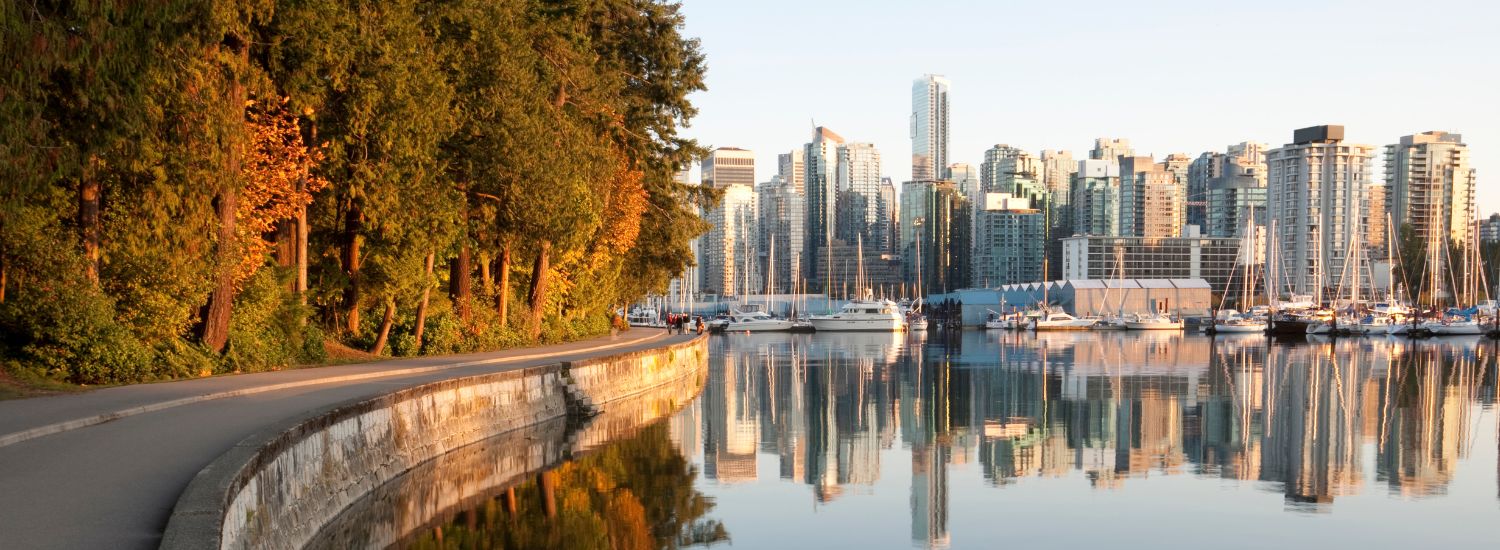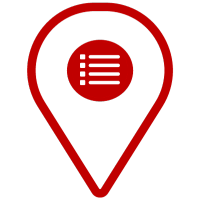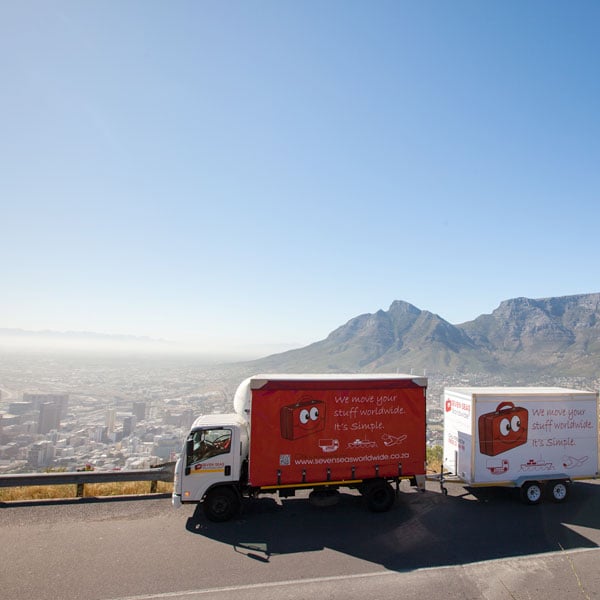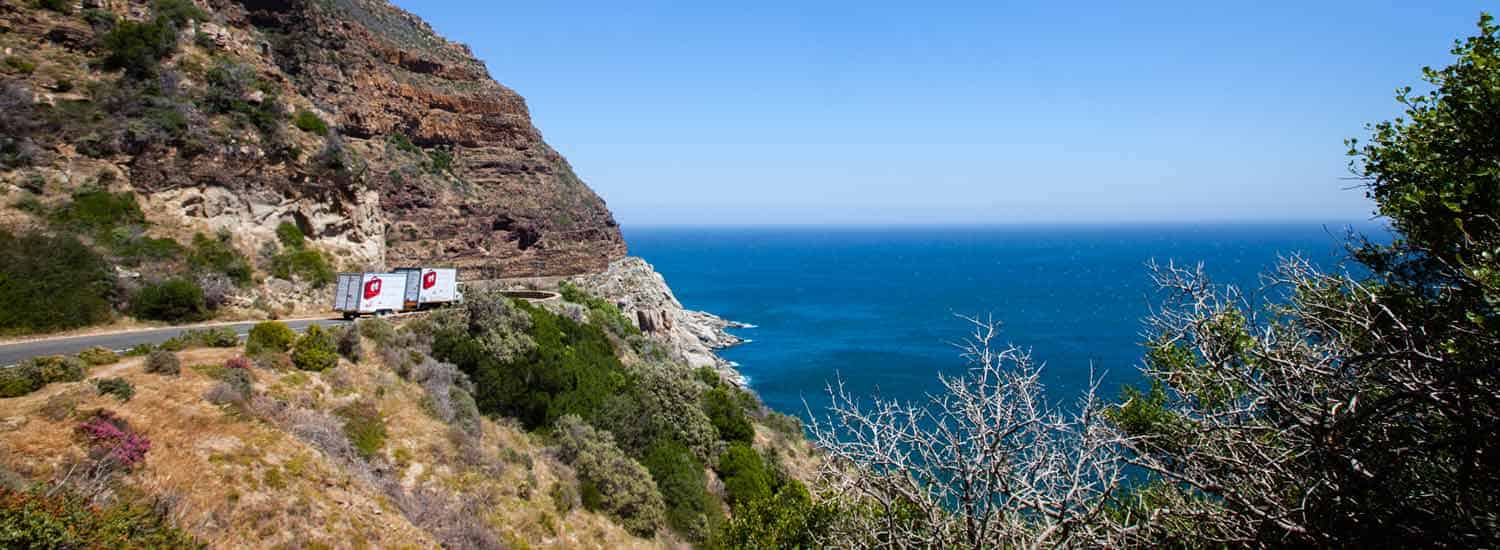Before packing, check this list of items prohibited from entering a particular country or region.

What to know before moving to Canada
Moving to Canada is a dream for expats looking to embrace adventure and spend more time in the great outdoors. From the rugged beauty of the Northwest Territories to the multicultural vibrancy of cities like Toronto and Vancouver, the Land of Maple Syrup delivers!
This guide covers everything you need to know about moving to Canada, including how to apply for a Canadian visa, tips on finding your dream job, living costs, Canadian culture, and much more!
Is Canada a good place to live?
Canada is a good place to live as it has one of the world's highest standards of living. Residents enjoy free healthcare, a multicultural population, safe streets and stunning landscapes. Plus, a strong economy, commitment to the environment and a rich cultural scene — what more could you want?!
Helpful information about living in Canada
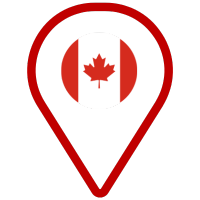
Quick facts about Canada
| Provinces | 10 |
| Territories | 3 |
| Capital | Ottawa |
| Population | 38.9M |
| Most populated city | Toronto, Ontario |
| Official languages | English and French |
| Area | 3.8M mi² (9.9M km²) - 2nd largest in the world |
| Currency | Canadian Dollar (CAD) ($) |
| Form of government | Federal parliamentary constitutional monarchy |
| GDP (total) | $2.3T - 16th in the world |
| GDP (per capita) | $59,813 - 28th in the world |
| Human Development Index (HDI) | 0.936 - 15th in the world |
(Sources: statcan.gc.ca, imf.org, hdr.undp.org)
From the rugged beauty of the Northwest Territories to the multicultural vibrancy of cities like Toronto and Vancouver, the Land of Maple Syrup delivers!
Time zones in Canada
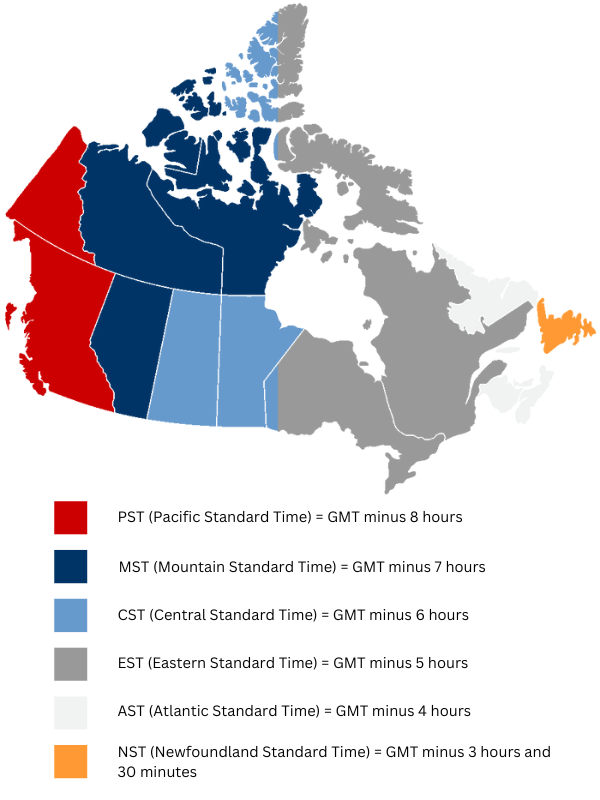
What percentage of Canada's population is immigrants?
Immigrants are
23% of Canada's population
Source: Statistics Canada

Canada immigration requirements: everything you need to know about the Canadian visa process
Canada is one of the best countries to live in and work, and an ever-popular destination for expats looking to start a new life in a prosperous country. But prepare yourself — the Canadian immigration process is not straightforward. There are hundreds of application methods, competition is high, and you may have to wait months or years for a decision. Your best chance of securing a move is having a desirable professional skill or getting sponsorship from a Canadian family member or employer.

How to move to Canada
To move to Canada you will need to determine your immigration eligibility and apply for an appropriate Canadian visa. Once your visa application has been approved, you must provide your identification documents, pass a criminal record check, undergo a medical examination, and then arrange a removals service. See below for more details.
Determine your eligibility and apply: research which immigration program you qualify for. The main pathways include Express Entry for skilled workers, Provincial Nominee Programs specific to each province or territory, and Family Sponsorship for those with Canadian relatives.
Gather your documents: ensure all your IDs, such as your passport, birth certificate, or marriage certificate, are within easy reach. Other items you might need when filling out your application include:
- Proof of educational credentials, e.g. degrees, diplomas and transcripts.
- Proof of work experience, e.g. letters of employment and resume.
- Language proficiency certificates.
- Financial documents, e.g. bank statements.
Medical and security checks: after submitting your Canadian visa application, you must undergo medical examinations and criminal checks.
Prepare for arrival: get ready for the big move to Canada by organising temporary housing, registering for healthcare and opening a bank account.
What is IRCC?
IRCC, or Immigration, Refugees and Citizenship Canada, is a government department that oversees all immigration and refugee matters in Canada, including citizenship. IRCC ensures the integrity of the immigration system and helps newcomers integrate into Canadian society.
The primary responsibilities of IRCC include:
- Processing immigration applications.
- Setting immigration levels.
- Developing immigration policies and programs.
- Managing refugee and asylum matters.
- Administering citizenship ceremonies and processes.
How to study in Canada
To study in Canada, you will need a Canadian Study Permit, which allows students to work twenty hours a week during school term and full-time hours during study breaks. You must be able to pay for your tuition fees upfront or prove that you have enough money to fund your stay, typically US$10,000.
A benefit of a Study Permit is that your spouse may qualify for an open work permit, allowing them to work full-time for any Canadian employer.
How to work in Canada after graduating: if you've studied for at least two years in Canada, you can apply for a post-graduation work permit. You can work in any occupation, but choosing a skilled role related to your qualifications is advisable to maintain your express entry points.
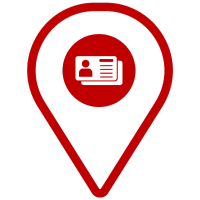
How to become a resident of Canada: express entry for skilled workers
Canada's Express Entry is a points-based program that assesses candidates based on age, education, work experience and language ability.
You can only create an Express Entry profile if you meet the requirements and pass the reading, writing, listening and speaking language tests in either English or French.
All Express Entry profiles are ranked against one another through the Comprehensive Ranking System (CRS) and assigned a score out of a total of 1200 points. The top candidates will then receive an invitation to apply for permanent residency.
You can work or study in Canada indefinitely if awarded a permanent stay. However, you must be present in the country for at least 730 non-consecutive days during the first five years.

Here are the three Express Entry immigration programs you can apply for:
The Federal Skilled Worker Program (FSWP): educated skilled workers could gain permanent residence in Canada via the FSWP with the following eligibility criteria:
- One year of continuous work experience acquired within the last ten years in your primary occupation.
- Minimum education requirements from a designated organisation, depending on the role. If your education was in Canada, your certificate, diploma or degree must be from a high school or post-secondary institution.
The Federal Skilled Trades Program (FSTP): the FST program allows workers qualified in a skilled trade to apply for permanent residency. Applicants must have at least two years of full-time work experience within the previous five years, a job offer or a certificate of qualification, and sufficient English or French language ability.
The Canadian Experience Class (CEC): the CEC is an entry program for skilled workers with Canadian work experience wishing to gain permanent residency. Minimum requirements include at least one year's Canadian work experience, or an equal amount of part-time experience, and English or French language ability.

Canada immigration process: how much is a Canadian visa?
A Canadian visa can cost between CA$100 and CA$2,385. Below are some of the most common Canadian pathways to residency and their base application costs*. However, check the IRCC website before applying, as prices depend on personal circumstances and are subject to change.
Note that the fees below don't include the additional CA$85 charge for biometrics (fingerprints and photograph), which citizens from certain countries will need to provide if applying for a visitor visa, study permit or work permit.
![]()
Temporary residence
- Study permit (including extensions): CA$150.00
- Temporary resident permit: CA$239.75
- Visitor visa (including super visa): CA$100.00
- Work permit (including extensions): CA$155.00
- Open work permit holder: CA$100.00
![]()
Permanent residence
- Business immigration: CA$2,385.00
- Caregiver program: CA$1,085.00
- Economic immigration (including Express Entry): CA$1,525.00
- Humanitarian and compassionate program: CA$1,210.00
![]()
Family
sponsorship
- Sponsor your relative (22 years or older): CA$1,205.00
- Sponsor a dependant, adopted child (or child to be adopted) or orphaned relative: CA$170.00
- Sponsor your parent or grandparent: CA$1,205.00
- Sponsor your spouse or partner: CA$1,205.00
Source: ircc.canada.ca
*prices accurate as of 2025
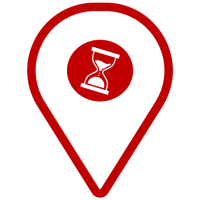
How long do Canadian visas take to process?
Canadian visas takes between one and seventeen months to process. However, as each application depends on personal circumstances like your current country of residency, visa subtype and IRCC staffing levels, precise times are difficult to predict.
Here are some recent estimated waiting times for common Canadian visa types:

Source: canadim.com
How long are Canadian visas valid?
Canadian visas are valid between 90 days and several years. However, the length of time you can spend in the country depends on which entry pathway you apply through. Here's how long some of Canada's most popular visas are valid for:
- Temporary Resident Visa (TRV): TRVs for tourism, business or visiting family and friends are usually valid for up to 6 months from the date of issuance.
- Study permit: typically valid for the duration of the academic program. If you finish your studies early, you will only have 90 days left on your permit.
- Work permit: visas for temporary foreign workers are issued for the duration of the job offer, usually between 1-2 years. Extensions may be possible depending on your specific circumstances.
- Family and partner visas: length of stay may be defined or permanent based on the specific visa subclass and the nature of your relationship.
Carefully read all the specifics of the visa you're interested in before applying. Please note that visa validity periods are subject to change and vary based on individual circumstances and immigration policies.
Visit the IRCC official website or consult a qualified immigration consultant for the most up-to-date information.
While an Express Entry program is your most likely way to gain entry to Canada, there are other options...
How can I apply for a Canadian visa?
You can apply for a Canadian visa by accessing a list of visitor visas and work permits and learning about the various entry requirements and necessary documents via the official Canadian government website. If you've made a paper application, you can link it to an online account to receive updates on your application's progress.
Canadian family immigration sponsorship explained
The Family Sponsorship Program allows Canadian citizens or permanent residents to nominate certain relatives for permanent residency in Canada. Your sponsor must be a citizen or a Canadian permanent resident, over 18 and reside in Canada. Eligible relatives include spouses, common-law partners, children and parents, subject to conditions.
Other routes to permanent Canadian permanent residency
While an Express Entry program is your most likely way to gain entry to Canada, there are other options:
A sponsored work permit: if a Canadian employer wants to sponsor you for a job and can prove that no permanent resident or Canadian citizen is available, they must complete a Labour Market Impact Assessment (LMIA) document.
The Provincial Nominee Program (PNP): every Canadian province and territory has its own PNP, which allows them to nominate individuals for permanent residency based on local labour market needs.
You must have a link to the area, such as Canadian family members or a record of completing education there. Each of the ten provinces and three territories has particular requirements, so research before applying.
The International Experience Canada (IEC) Program: the IEC program allows young citizens (18-35 or, in some cases, 18-30) to live in Canada for up to two years and gain invaluable life, language and work skills. Get started now by searching for your country's particular arrangement with Canada.
The Start-up Visa Program: if you're an entrepreneur with a business idea that has the potential to create jobs in Canada, a Start-up Visa could be your best option.
However, there are several requirements. You must have a qualifying business, the backing of a qualifying Canadian organisation, letters of support and enough money to settle in Canada. The application process can take up to 16 months, and you'll also have to pay a fee of CA$2,385.

What is a Canadian diversity visa?
While Canada doesn't have a diversity visa (unlike the US's green card lottery), its immigration system aims to attract individuals with various skills and cultural backgrounds to contribute to the country's social and economic growth.
Several programs aim to promote diversity and welcome immigrants from a mix of backgrounds. One of the best-known is the Express Entry system for skilled foreign workers who wish to live and work in Canada permanently. Applicants are assessed on age, education, work experience, and language proficiency.
As the current Prime Minister of Canada, Justin Trudeau, famously said, "Canada will continue to champion diversity, acceptance and compassion on the world stage. We cannot build a better world unless we work together, respect our differences, protect the vulnerable, and put people at the heart of the decisions we make."
What is the Canada visa lottery?
Canada doesn't have a visa lottery like the United States's Diversity Immigrant Visa Program, which allows individuals from specific countries to apply for visas through a random selection process.
Instead, Canada offers various immigration programs based on factors such as skilled work experience, education, language ability and family ties. Applicants must meet the eligibility requirements outlined on the IRCC website.
Canada IEC program: what is it, and who's eligible?
The International Experience Canada (IEC) program is a government initiative that allows young people worldwide to travel and work in Canada for up to two years. For many, it's a life-changing opportunity to gain invaluable language, work and social skills in a welcoming, vast and varied country.
The age limit for eligibility is 18-35. However, rules differ from country to country, with some age limits capped at 30. There are various health and character requirements, and you must have sufficient funds to support yourself. Processing time is roughly three weeks, and fees begin at $179.75.
How to apply for the Federal Skilled Worker Program Canada
To apply for the Federal Skilled Worker Program (FSWP) — a key pathway for educated and experienced professionals wishing to immigrate to Canada — you must create and submit an Express Entry profile. Eligibility criteria includes at least one year of continuous full-time or equivalent part-time skilled work experience, language proficiency in English or French, and enough funds to settle in Canada.
You'll be invited to apply for permanent residency if you have the required points based on your eligibility score.

Can I retire in Canada?
You can't retire to Canada as there isn't currently a Canadian retirement visa. Most of Canada's visa programmes focus on those who can boost the country's economy via employment. Your best option is to either take up work in some capacity or receive sponsorship via a qualifying family member.

Canadian citizenship: everything you need to know
The Canadian Citizenship Act, established in 1946, allows Canadian residents to apply for full citizenship regardless of nationality. It's known as naturalisation.
For many, obtaining citizenship is more than a formality — it's about connecting with fellow compatriots and fully integrating into Canadian life. Plus, you'll gain the right to vote, live and work in Canada, run for office, apply for a passport and come and go as you like.
Here's how the process works in three steps:
1. Check if you're eligible for Canadian citizenship
To begin applying for citizenship, you must have permanent resident status in Canada with no unfulfilled conditions, such as being under review by the law.
Further conditions include:
- Passing a Canadian citizenship test.
- Attending a citizenship ceremony and taking an oath of citizenship.
- Proving your English/French language skills if aged 18-54.
- Having up-to-date taxes.
- Living in Canada for at least three of the past five years.
For the complete list of requirements, check the official Canadian government website.
2. Complete the Canadian citizenship application
You can apply for Canadian citizenship via paper or online. Online applications are the most common method and recommended. You must complete several forms, including a checklist of all required supporting documents (CIT 0007) and the application itself, which will be the Adults (CIT 0002) form for most people.
Supporting documents include:
- Colour photocopies of your passport pages or travel documents.
- A printed or digital copy of the CIT 0407 ("How to Calculate Physical Presence") form.
- Photocopies of two forms of ID, such as a driver's licence, valid passport, or a Canadian permanent resident card.
- Evidence of passing French or English language tests if you fall between 18 and 54.
Answer all application questions fully unless otherwise instructed. Depending on your circumstances, you might also need to complete the following forms:
- Use of a representative (IMM 5476)
- Residence outside Canada (CIT 0177)
- Request to change sex or a gender identifier (IRM 0002)
- Request to correct date of birth for citizenship (CIT 0464)
Once complete, pay your application fees and submit your citizenship application alongside your supporting documents and your fee payment receipt. A Canadian citizenship application costs CAD$649.75 for adults over 18 and CAD$100 for those minors.
3. Wait for application approval
On average, Canadian citizenship applications take around 15 months to process. However, several factors will affect your wait time, including:
- The type of application submitted;
- How complete your application is;
- Current backlogs;
- How easily verifiable your information is;
- Your response time to any requests or concerns.
If approved, you'll be invited to a citizenship test and interview. The test lasts 30 minutes and consists of 20 questions on Canada's geography, government, laws, etc. You can take the test in French or English — you'll need to answer at least 15 questions correctly to pass.

Canadian citizenship test questions
The Canadian citizenship test consists of twenty multiple-choice questions quizzing the participant on their knowledge of the official reference book, "Discover Canada: The Rights and Responsibilities of Citizenship".
See how much you know about the Great White North with these practice questions:
1. Who is Canada's Prime Minister?
a) Justin Trudeau
b) Michaëlle Jean
c) Stephen Lewis
d) Dalton McGuinty
Answer: a
2. What's the first line of Canada's national anthem?
a) O Canada! From far and wide, O Canada,
b) O Canada! Our province and native land!
c) O Canada! We stand on guard for thee.
d) O Canada! Our home and native land!
Answer: d
3. Which province do one-third of all Canadians live in?
a) Quebec
b) Ontario
c) Northwest Territories
d) Manitoba
Answer: b
4. What's Canada's national winter sport?
a) Nordic skiing
b) Lacrosse
c) Hockey
d) Golf
Answer: c
5. When is Remembrance Day celebrated?
a) October 1st
b) July 1st
c) December 25th
d) November 11th
Answer: d
How easy is it to move to Canada?
Moving to Canada is a complex process and depends on several factors, such as your nationality, qualifications, work experience, the type of visa you're applying for and whether you have a job offer in Canada. You must also consider how best to move your personal effects overseas. The easiest way to do this is by hiring a professional international shipping company and using a self-loading moving pod like the Seven Seas Worldwide MoveCube®.
The easiest way to move permanently is to have skills suited to an in-demand role in Canada. You can apply via the Federal Skilled Worker program — the more points you are awarded, based on factors like language ability and education, the more likely your chance of securing a permanent stay.

Renting vs. buying a home in Canada
Once you've picked an area of Canada to move to, you'll need to decide whether to buy or rent. Renting lets you acclimate to your new surroundings before committing to buying a home. Plus, you might discover that Canada is unsuitable and that you want to return home. Alternatively, buying means you invest your money immediately and can start building solid roots in your new home.
And remember to secure temporary accommodation at a local hostel, hotel or Airbnb for a roof over your head while viewing homes!
![]()
What documents do you need for a rental agreement in Canada?
The documents your potential landlord will ask you to provide for a rental agreement in Canada typically include:
- Employment verification: a confirmation of your job that displays your position, start date, duration and salary, sent directly from your employer to your landlord.
- Proof of income: you'll need to provide two or more months of payslips showing your hourly rate, your company's name and how many hours you work.
- Reference from a previous landlord: this could be a letter from your current or former landlord or a recommendation from an estate agency detailing if you paid on time and looked after the property.
- Character/personal reference: you may also need a professional reference from someone who knows you well, typically a manager or the CEO. If you haven't worked before, a reference from a friend, neighbour, teacher or community leader should be acceptable.
- Credit report: your landlord may perform a credit check to determine your payment history, any outstanding debts, and if you've ever declared bankruptcy.
Renting property in Canada
Research your chosen city or town online before arriving in Canada. Consider rental prices, work proximity, parking, public transport, schools, crime rates and local amenities. Popular letting websites such as Realtor, PadMapper and Viewit are excellent resources. Alternatively, hire a realtor on Realtor or Condos.ca to help you find a home. Realtors use their invaluable expertise to find the perfect home for you and your family free of charge.
View potential homes in person if possible. You'll get a better sense of the house and can ask the property manager for more information. Choosing somewhere based purely on images, video, and text can be misleading.
Top tip: most rental contracts in Canada are for one year. However, if needed, you can find properties available to sublet/sublease for between one and eleven months. Subletting laws differ in each city and province, so research is necessary. You'll likely still need to sign a lease and pay a security deposit, though. Use websites such as Sublet and Rentals.ca to find a temporary home.
After choosing a property, you'll need to provide an employment letter displaying your job's duration and salary. Plus, your credit report and bank statements to ensure you can afford rental payments. However, as a newcomer to the country, you might not have this information. Instead, proving you have sufficient funds to cover a few months' rent or providing a local guarantor typically suffices.
Next, read your lease agreement. It details the rent you'll pay, the duration of the contract, rules on pets, subletting, smoking, terminations and more. Then, sign two copies of your lease, one for you and one for your landlord, pay the first and last months' rent, make the security and key deposit, and buy tenant insurance. Once all paperwork and payments are complete, your landlord will hand over the keys to your new home.
Buying a house in Canada
Start by creating a budget to determine if you can afford a mortgage. You'll need a down payment of between 5 and 20%, depending on the value of your desired home. However, if your down payment is less than 20%, you must purchase mortgage default insurance via Canada Mortgage and Housing Corporation (CMHC) or Sagen. Then, assess your credit score on sites like Equifax, CreditKarma and TransUnion, to evaluate your likelihood of getting a mortgage and learn score improvement tips.
Next, apply for a pre-qualified mortgage from a few banks. Trusted institutions include the Royal Bank of Canada, Toronto-Dominion Bank and the Scotiabank. To qualify, you must pass what is known as a bank's stress test, which assesses if the borrower can afford the mortgage even if interest rates rise. The test takes looks:
- The mortgage amount;
- Current interest rates;
- The amortization period;
- Your household income;
- Housing costs;
- Your current debt.
View as many homes as possible via property sites like Realtor and Zoocasa. Once you find a few you like, ask a realtor to help narrow your selection, and with their guidance, place a bid. If your offer is accepted, your bank will appraise the home to confirm its value and condition.
Once your offer is in place, your bank will submit all necessary paperwork to your lawyer for review and prepare legal purchase documents. Ensure your budget includes closing costs to cover your lawyer's fees, land transfer tax, property taxes and inspections.
To qualify, you must pass what is known as a bank's stress test, which assesses if the borrower can afford the mortgage even if interest rates rise.

How much money do you need in the bank to move to Canada?
The amount of money you need in the bank to move to Canada is roughly CA$17,257 for one person and CA$22,000 for couples, according to e-visa immigration. However, depending on your pathway to Canadian residence, you may or may not need to provide proof of funds.
Opening a bank account in Canada for non-residents
To open a Canadian bank account as a non-resident, visit a few local branches in person and do some online comparisons. The five major banks in Canada are the Royal Bank of Canada (RBC), Toronto-Dominion Bank (TD Bank), Bank of Nova Scotia (Scotiabank), Bank of Montreal (BMO) and Canadian Imperial Bank of Commerce (CIBC).
Here are some examples of common Canadian bank accounts:
Checking account: for day-to-day banking, including receiving wages and paying bills like utilities, groceries, petrol, etc. Most accounts include monthly fees. However, you'll avoid a fee if your account is in the CA$5,000 to CA$6,000 range or above.
Savings account: to save money for use later while earning interest. Such accounts have higher interest rates than transaction accounts and usually no monthly fees.
Guaranteed Investment Certificates (GICs): savings accounts that typically earn higher interest than regular savings accounts if left untouched for a fixed amount of time, generally at least one year.
Newcomers and non-citizens can open a bank account in Canada without a job or regular income. But you must prove your identity using your passport, proof of status in Canada, or proof of address, and open your account in person. Many of the central banks, including RBC and BMO, offer dedicated accounts for newcomers with low or no fees and other special offers.
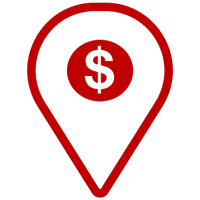
Ways to transfer money to a Canadian bank account
Here are a few ways to transfer money into your new Canadian bank account seamlessly:
- Bank/money transfer: an international wire transfer from your current bank to a Canadian bank. You must provide your Canadian bank with the SWIFT/BIC code and any other required information. The process is very secure but may include high fees and take a few days to complete.
- Online money transfer: platforms like PayPal, Wise and Revolut let you send money online using their app or website at lower fees than traditional banks.
- International bank draft or cheque: ideal if you feel more comfortable depositing physical paperwork at your Canadian bank. It may take longer to process, but it is usually cheaper.

Transferring savings to Canada
When moving to Canada, there are several options regarding your online savings account in your home country. Here are a few considerations:
Keep your account open: if your account is with a bank that operates in or has partnerships with Canadian banks, you could continue using it from Canada. Fees or restrictions may apply, so contact your bank immediately.
Transfer to a Canadian bank: consider moving the funds to a bank in Canada that has the features you need, such as low fees and local branches. Then, initiate an international money transfer between the two banks or an online transfer with a service such as Wise.
Close the account: if keeping the account open or transferring funds to a Canadian bank is not possible or desirable, you can shut down the account before relocating. Remember to withdraw any remaining funds and pay due fees before closing the account.

Working and getting a job in Canada
With over seven hundred thousand job vacancies across Canada, expats have ample opportunity to secure a position. Your best chance is to fill an in-demand role via the Express Entry program. Work experience plays a significant role in acceptance, so you don't necessarily need a university degree or other formal qualifications.
If your profession isn't in demand, several alternative options exist, including temporary work visas, working student visas and the International Experience Canada (IEC) program.
Utilise popular job listing websites, such as Monster, Indeed and Glassdoor and connect with potential employers and recruiters on LinkedIn, a job searching platform designed for professionals.
Tips for job hunting in Canada
Before starting your job search, understanding the working conditions of your visa is essential. For example, is there a limit to how many hours per week you can work? Does your contract have a defined end period? Check your working visa's terms and conditions on the Canadian government website.
Next, research Canada's biggest employers and industries to determine where your skills fit best. The government website Job Bank lets you search for jobs and explore employment trends and industry outlooks specific to your desired role and location.
Then, make several resumes tailored to different aspects of your skills. For example, one version might emphasise your problem-solving abilities if applying for a job in IT, and in another, your polite and professional manner for a sales position.
Utilise popular job listing websites, such as Monster, Indeed and Glassdoor and connect with potential employers and recruiters on LinkedIn, a job searching platform designed for professionals.
You can utilise Settlement Online Pre-Arrival (SOPA) if your permanent residence is approved. SOPA is a government-run career service that provides helpful information on jobs, workplace culture, settlement, coaching, etc.
Further job-searching methods include:
- Attend networking events and career fairs related to your field of work to build connections.
- Create and practise your "elevator pitch" to sell your abilities and experience in a few sentences.
- Show initiative by volunteering or taking up an internship related to your skills.
- Register with recruitment agencies who can directly connect you with employers.
- Go directly to your preferred employer's website to check for vacancies. If there are none, email them your resume anyway — you never know!
- If English or French is not your first language, consider improving your language skills to enhance your job prospects.
Stand out from the crowd by researching successful Canadian resume layouts, and write a thoughtful cover letter highlighting your abilities and desire to go the extra mile. Learn as much as possible about the company beforehand, starting with their website's "About Us" page.
Finally, remember that securing a job in a competitive market requires persistence and resilience. Apply for as many roles as possible and keep making connections; you'll land your dream Canuck job in no time!
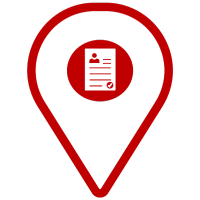
Canadian employment statistics
| Avg. weekly working hours | 31.7 |
| Avg. annual income | CA$63,859 |
| Full-time employed | 17.19M |
| Part-time employed | 3.85M |
| Vacancies | 524,300 |
Sources: jobbank.gc.ca, ycharts.com,150.statcan.gc.ca
Top 10 jobs in demand in Canada
The top 10 jobs in demand in Canada are registered nurses, web developers, electrical engineers, truck drivers, welders, veterinarians, licensed practical nurses, industrial electricians, pharmacists and accountants, according to Canadim.
The graph below orders these roles by their expected average earnings in CA$, and each has its corresponding NOC code*.

*The National Occupation Classification (NOC) system categorises every job in the Canadian labour market with a corresponding code and detailed description. Accurate identification of your NOC code is essential when immigrating to the country through the Express Entry program.
FAQs about moving to Canada for expats
To apply for a Canadian visa, research visitor visas and work permits on the official Canadian government website to learn about entry requirements and required documents.
The processing time for Canadian visas is dependent on personal circumstances. Factors include the Canadian region you're moving to, your pathway to entry, and your country of origin.
We advise checking the official Canadian Immigration website for current processing estimates. Ensuring accuracy and including all requested documents will contribute to a more efficient visa processing experience.
The length of time your Canadian visa is valid depends on your entry pathway. Be sure to carefully read your desired visa's specifics before applying.
Visit the official Immigration, Refugees and Citizenship Canada (IRCC) website or speak to a qualified immigration consultant for the latest information.
The money needed to move to Canada depends on your chosen pathway. Based on factors like visa application and processing fees, language tests and temporary housing costs, e-visa immigration estimates CA$17,257 for individuals and CA$22,000 for couples.
Choosing where's best to live in Canada depends on personal preferences, lifestyle choices, schools and career opportunities. Cities like Toronto and Montreal have a cosmopolitan vibe, more jobs and a dynamic cultural scene. Alternatively, the rural landscapes of Northern Canada offer a more tranquil way of life.
Canada's top 10 in-demand jobs are nurses, web developers, electrical engineers, truck drivers, welders, veterinarians, licensed practical nurses, industrial electricians, pharmacists and accountants.
The best universities in Canada are the University of Toronto, the University of British Columbia, McGill University and McMaster University.
Living in Canada is full of exciting experiences, from lively cities to the quiet vastness of the Northern wilderness. Canadians enjoy tax-funded universal healthcare, a high quality of life, multiculturalism and gorgeous landscapes.
You can move to Canada without a job offer thanks to skills-based immigration options, such as Express Entry and the Provincial Nominee Program. Other non-work options include a student visa or family sponsorship.
Canadian import laws allow most domestic pets to enter the country. However, some requirements and restrictions depend on the animal type, country of origin and your pet's health status. Reference the Canadian Food Inspection Agency (CFIA) website before travelling for the latest information.

Canada history timeline
Pre-1600s
Indigenous peoples in Canada, including First Nations, Métis and Inuit, have inhabited the land known as Canada for thousands of years, developing rich traditions, societies and languages.
1600s
In 1497, Italian explorer John Cabot, representing England, reached the east coast of Canada, laying claim to the land. Soon after, Jacques Cartier proclaimed the land for France in 1534.
1700s
The British North America Act of 1867 established the Dominion of Canada, uniting the provinces of Ontario, Quebec, New Brunswick and Nova Scotia.
1800s
Throughout the late 19th century, Canada experienced rapid expansion, including the completion of the Canadian Pacific Railway in 1885, facilitating trade across the country.
1900s
In 1931, the Statute of Westminster granted Canada legislative independence from Britain. However, formal constitutional ties remained until the passage of the Constitution Act of 1982.

Canadian culture: values, traditions, food and more!
Depending on where you're from, Canadian customs and quirks might take a little getting used to. If you're used to living in the UK, USA or other English-speaking countries, you'll notice similarities but also significant differences in lifestyle:
- Politeness and respect: famous for their niceness, Canadians often use phrases like "eh" and "sorry" and love chatting with strangers. The national concept of "neighbourliness" emphasises a welcoming spirit and strong community bonds.
- Indigenous heritage: indigenous peoples, including First Nations, Métis, and Inuit, have inhabited the land now known as Canada for thousands of years. Their influence has profoundly influenced Canadian culture via art, stories and traditions. National Indigenous Peoples Day and similar events celebrate and honour indigenous Canadian cultures.
- Check your plugs: Canada uses type A and B electrical outlets and plugs. Type A outlets have two flat parallel pins, while type B outlets include an additional grounding pin. The standard supply voltage is 120V, and the frequency is 60Hz. Using plug adapters on arrival is advised, however long-term use is considered unsafe.
- Sports culture: Canadians have a true passion for sports, particularly ice hockey, soccer, basketball and Canadian football. Crowd-drawing events, such as the Stanley Cup playoffs and the Grey Cup, unite the nation and instil national pride.
- Winter celebrations: as a nation accustomed to chilly weather, Canadians enthusiastically embrace the long winter months! Various winter festivals, such as Winterlude in Ottawa and the Quebec Winter Carnival, are ever-popular celebrations.
- Multiculturalism: Canada is known for its melting pot society, where people from different backgrounds contribute to its cultural and economic output. Respect for diversity and celebrating traditions are fundamental characteristics of Canadian identity.
10 surprising facts about Canada
- Not only does Canada produce the majority of the world's maple syrup, but it was also a victim of the "Great Canadian Maple Syrup Heist". In 2011 and 2012, thieves stole over 19,000 barrels of maple syrup from a storage facility in Quebec worth more than CA$18 million!
- In Churchill, Manitoba, troublesome bears that wander too close to human settlements are sent to "Polar Bear Jail". After a short detention, the bears are safely released back into the wild and away from people.
- You can order a drink named the "Sourtoe Cocktail" in Dawson City, Yukon, which includes a mummified human toe. The rule is that the toe must touch the drinker's lips. But be warned, there's a hefty fine if you swallow it!
- Basketball, one of the USA's premier sports, was invented by Canadian James Naismith in 1891 while working as a PE teacher at the International YMCA Training School in Springfield, Massachusetts.
- Yonge Street in Toronto holds the Guinness World Record as the longest street in the world. It stretches approximately 53 miles from the shores of Lake Ontario in Toronto to the Rainy River at the Ontario-Minnesota border.
- Canada has its own postal code for letters addressed to Santa Claus. Thousands of children worldwide write to Santa annually using "H0H 0H0".
- Nackawic, New Brunswick, is home to the world's largest axe. The 15-metre tall, 55-ton giant sculpture is a tribute to the area's history of forestry.
- The Okanagan Desert in British Columbia is the only desert in Canada. Orchards, vineyards and beautiful lakes surround the semi-arid shrubland.
- Newfoundland's Northeast coast is home to "Iceberg Alley", where massive icebergs float up from the Arctic every spring and summer.
- British Columbia's Kisault is a perfectly preserved "ghost" town. It was built in the 1970s to accommodate a molybdenum mine just before molybdenum crashed in value. It remains eerily untouched today, with houses, streets, a shopping mall, a bowling alley, and more fully intact.
Canada has its own postal code for letters addressed to Santa Claus.


A handy guide to the cost of living in Canada
The cost of living in Canada varies by region, town and city, so ensure you budget for accomodation, utilities, education, healthcare, transportation and food. Housing costs, including rent or mortgage payments, are typically the most significant expense, especially in major cities like Toronto and Vancouver. Expats in Canada must also consider medical expenses not covered by Medicare, like prescriptions, dental care and eye care.
However, the standard of living in Canada is high, which offsets the cost. There's free public healthcare for all residents for essential medical services — plus, crime is low, the economy is strong, and unemployment is just 6.9% as of 2025.
How much does moving to Canada cost?
The of moving to Canada depends on your circumstances, considerations include application fees, flights, temporary accommodation and international removal costs.
Below, we provide further information about potential budget costs:
Visa application costs:
Depending on your residence pathway, there are application and processing fees known as Embassy Fees. Canadian visas that have associated costs include permanent residence visas and family sponsorship. Reference the IRCC website for the most up-to-date information.
Travel expenses:
The cost of flights to Canada depends on where you're departing from, the time of year, the flight class and the airline. International flights typically range from a few hundred to several thousand Canadian dollars. Save money by booking in advance and using flight comparison websites like Skyscanner and Flights Finder.
Temporary accommodation:
Buying a home on arrival in Canada is a big commitment. Instead, consider renting a property first. Doing so lets you settle into your new surroundings and lifestyle before making a significant decision like purchasing a home. Plus, you might decide to try another Canadian city or realise that you miss home and want to return.
Search for the perfect temporary home on PadMapper, Zolo or Realtor. Housing costs vary across the country depending on the region, accommodation type, and size. According to Rental's 2025 rent report, St. John's, Newfoundland and Labrador, ranks the cheapest with an average rental cost of CA$1,013 per month for a 1-bed home. North Vancouver, British Columbia, is the most expensive, at roughly CA$2,602 per month for a 1-bed property.

How to move to Canada with no money
It's almost nearly impossible to move to Canada with no money. However, here are steps you can take to keep costs low:
- Apply for Express Entry: if you have valuable skills, education, or work experience, consider applying for Express Entry. Base application fees are more affordable than other Canadian visas, ranging from CA$950 to $1,525.
- Look for job opportunities: search for in-demand job opportunities that match your skills and qualifications. Use online job boards, networking sites like LinkedIn, and recruitment agencies to find potential employers in Canada who may be willing to sponsor your immigration.
- Explore settlement service: many provinces and territories offer free services to newcomers, including help finding housing and employment, language training and guidance on accessing government benefits.
- Consider temporary options: if you cannot secure permanent immigration status immediately, consider short-stay options like student visas, temporary work permits or a visitor visa. It could be an invaluable chance to build networks and improve your chances of obtaining permanent residency in the future.
Is it expensive to live in Canada?
The average expense of living in Canada varies depending on your location, lifestyle and family size. However, expenses in Canada are considered moderate compared to other developed countries. However, the minimum wage is high (CA$17.75), Canada has one of the world's highest average monthly salaries, and most expenses are typically cheaper than in the US.
Before deciding, research the provinces you're interested in, work out your income and likely expenses and create a budget. The Canadian government provides cost of living advice on its official website.
- Housing: rental and property costs vary across cities and provinces. Toronto, Vancouver and Montreal are more expensive than smaller cities and rural areas. The average price of owning a home in Canada is currently CA$487,540, while renting costs, on average, CA$2,149 per month.
- Utilities and bills: research how much your energy bills, such as electricity, natural gas, water and sewage services, will cost using comparison websites like Energy Shop and Energy Rates.
- Transportation: according to Statistics Canada, the average Canadian household spends around CA$841 per month commuting. Public transport in the bigger cities is generally cheaper than driving, so consider leaving your car at home — it also helps our precious planet!
- Food: worldwide cost of living database Numbeo estimates a three-course meal for two in Canada on average costs CA$100, a McDonald's McMeal CA$15 and a Coca-Cola CA$2.89. For grocery shopping, a litre of milk and a loaf of white bread costs CA$7.29 in Toronto, CA$7.35 in Vancouver, CA$6.60 in Edmonton and CA$5.30 in Winnipeg.
- Healthcare: Canada's healthcare system, known as Medicare, is funded by taxation, providing residents with universal coverage for essential medical services. However, you must pay for additional expenses like prescription medications, vision and dental care and rehabilitation services.

Cost of living in Canada*
Below are average prices (CA$) for some essential goods and entertainment options in Canada:

What is the minimum wage in Canada?
The federal minimum wage in Canada is
CA$17.75 per hour
Source: Wage Point
*prices accurate as of 2025

How international removals to Canada work
Seven Seas Worldwide has shipped home belongings worldwide for more than 25 years. From Vancouver to Toronto, we'll safely ship furniture, kitchen appliances, boxes, bags, bikes and more wherever you settle in Canada. Our expert team, complimentary packing supplies, free storage and multilingual customer support set us apart from other international removals companies.
What is Seven Seas Worldwide's MoveCube® shipping crate?
Seven Seas Worldwide's secure moving pod, the MoveCube® is a dedicated shipping container, which is brought to your door for you to fill with furniture, kitchen appliances, bicycles, musical instruments, bags, boxes and more!
Each MoveCube® order comes with a complimentary Starter Pack to help you wrap and secure your possessions. Inside, you'll find a measuring tape, a marker pen, a box cutter, a roll of parcel tape and a tape dispenser. Plus, three plastic sheets you can use to assess what will fit inside a Large, Medium or Small MoveCube®.
You can order as many MoveCubes® as required, but please note they may arrive on separate days if you order more than one. Start your exciting new life in the Great White North today with an instant free quote for a transparent cost breakdown of the entire moving to Canada process.
Another benefit of choosing our overseas removal service is that we guide you through the Canadian customs process. However, there are several things you should be aware of before packing your boxes and moving household items to Canada.
- Like all countries, Canada has restricted certain items from importation to protect its people and environment. Reference our Prohibited Goods page before packing to avoid delays or fines.
- Complete all your online documents and ensure your inventory (an itemised list of everything you're shipping to Canada) matches what's inside the MoveCube®.
- Upload clear, colour scans of your passport's picture and signature pages.
- Ensure that any wood, plant life, or animal by-product and its derivatives you want to ship are not classified as endangered by CITES (Convention on International Trade in Endangered Species of Wild Fauna and Flora).
New immigrants to Canada must complete a BSF186 form, also known as a "Personal Effects Accounting Document". It must be stamped at a RED customs channel upon arrival in Canada to avoid taxes or duties on your shipment.
Please note that you must be present in Canada when your shipment arrives. Your local Seven Seas Worldwide office will inform you once your goods arrive in Canada and are awaiting customs clearance.
You must present your customs documents to a Canadian Customs Office in the city where your shipment is located. Once your goods are cleared, your Cargo Control Document (supplied by us) will be stamped as "PARS PERMITTED". Finally, email us your proof of customs clearance, and we'll arrange the delivery of your shipment to your new Canadian address or from one of our depots.
Please reference our Importing into Canada page for a complete breakdown of the Canadian customs process.
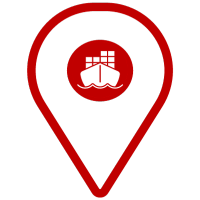
Transit times for shipping to Canada
Here are the estimated transit times for shipping one Large MoveCube® via sea from the capital cities of our ten most popular routes to Ottawa, Canada:
| Origin country | Transit time* |
| China | 90 days |
| France | 123 days |
| Hong Kong | 96 days |
| Ireland | 136 days |
| Malaysia | 96 days |
| Netherlands | 123 days |
| New Zealand | 114 days |
| Singapore | 96 days |
| Thailand | 84 days |
| UK | 99 days |
*estimated timings dependent on global shipping circumstances.





